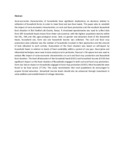| dc.contributor.author | Kumba, Janepha K. | |
| dc.contributor.author | Wegulo, Francis | |
| dc.contributor.author | Otieno, Joseph | |
| dc.date.accessioned | 2015-04-09T08:43:25Z | |
| dc.date.available | 2015-04-09T08:43:25Z | |
| dc.date.issued | 2015 | |
| dc.identifier.citation | Kumba, Janepha K., Francis Wegulo, and Joseph Otieno. "The Impact of Socio-Economic Characteristics on Cash and Food Crop Production: Implications on Household Food Situation in Kisii Central Sub-County, Kenya." Developing Country Studies 5.5 (2015): 115-122. | en_US |
| dc.identifier.uri | http://iiste.org/Journals/index.php/DCS/article/view/20510 | |
| dc.identifier.uri | http://hdl.handle.net/11295/81961 | |
| dc.description.abstract | Socio-economic characteristics of households have significant implications on decisions related to utilization of household farms in order to meet food and non-food needs. This paper aims to establish the impact of socio-economic characteristics on cash and food production and the resultant household food situation in Kisii Central sub-County, Kenya. A structured questionnaire was used to collect data from 209 household heads drawn from three sub-Locations with the highest population density within the LM1, UM1 and LM2 agro-ecological zones. Data on gender and education level of the household heads, household size, farm size and household income was collected. The cash and food crop production data collected was the number of households involved in their production and the amount of land allocated to each activity. Assessment of the food situation was based on self-report by household heads in relation to levels of food availability within a period of one year. Descriptive and inferential techniques were used in data analysis and in particular, Pearson’s Chi-square test was used to analyze the impact of socio-economic characteristics on cash and food crop production and household food situation. The level of education of the household head (0.021) and household income (0.019) had significant impact on the food situation of households engaged in both cash and food crop production. Farm size had an impact on households engaged in food crop production (0.001). Most households were found to be food secure (77.5%). This study recommends that rural populations be encouraged to acquire formal education. Household income levels should also be enhanced through investment in value addition and establishment of cottage industries. | en_US |
| dc.language.iso | en | en_US |
| dc.publisher | University of Nairobi | en_US |
| dc.subject | Cash and food crop production, Household socio-economic characteristics, Food situation | en_US |
| dc.title | The impact of socio-economic characteristics on cash and food crop production: implications on household food situation in Kisii central sub-county, Kenya | en_US |
| dc.type | Article | en_US |
| dc.type.material | en | en_US |

